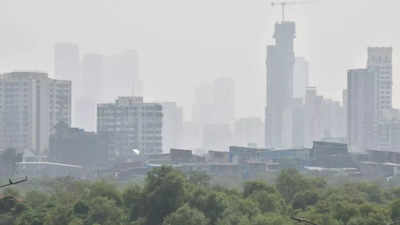- News
- City News
- mumbai News
- Mumbai air quality plunges again, but better than smoggy Delhi
Trending
Mumbai air quality plunges again, but better than smoggy Delhi
Mumbai's air quality plummeted on Tuesday, with four areas experiencing 'poor' air quality due to high PM2.5 concentrations. Residents reported thick smog and respiratory problems. Experts attribute the decline to low wind speeds, moisture, and emissions from various sources, trapping pollutants and creating sultry conditions. While Delhi's AQI was worse, Mumbai's air poses significant health risks, particularly to vulnerable populations.

Track the pollution level in your city
Delhi is considered one of the most polluted cities in the world, especially during winter, thanks to stubble burning. However, the toxicity in Mumbai's air is considered to be at a higher level due to the increasing concentration of toxic PM2.5 caused by automobiles, industries, construction activities and garbage burning.

AQI is a concentration of toxic particulate matter PM2.5 or PM10 in the air, whichever is higher.
Chembur resident Kavya Nayak said the smog was so thick on Tuesday morning that she couldn't view Eastern Express Highway from her 30-storey building.
Amisha Sinha, a Malad resident, said many in her building visited doctors for air-borne infections.
Kharghar residents complained of gases being released into the air from Taloja and surrounding industrial areas.
In all, 17 out of 25 locations that were monitored on Tuesday showed non-satisfactory levels. Some of the suburbs that showed non-satisfactory levels of air quality on the higher side included BKC, Borivli East, Chembur, Vasai West, and Malad West.
According to weather experts, a dip in temperature, low wind speed combined with moisture-laden air causes emissions and dust from automobile, industrial, and construction activities to remain suspended in the air instead of being blown away by the sea breeze. The particulate matter trapped in moisture gets warmer due to temperature and eventually makes climatic conditions warmer and sultry.
While poor AQI may cause breathing discomfort to people on prolonged exposure and discomfort to people with heart disease with short exposure, the non-satisfactory levels can cause breathing discomfort to people with lung disease such as asthma, heart disease, and children and older adults.
End of Article
FOLLOW US ON SOCIAL MEDIA
Visual Stories
Hot Picks
TOP TRENDING
Explore Every Corner
Across The Globe
CSK Full SquadMI Squad Projected 11IPL Most Expensive PlayerVaibhav SuryavanshiCKS Squad Projected 11
IPL Teams SquadsIPL AuctionIPL 2025 Mega Auction Players ListIPL Auction Unsold Player ListPBKS IPL Team Player List
LSG IPL 2025 Player ListGT Team IPL Player ListRR IPL Player ListRCB IPL Player ListGT Squad Projected 11
MI IPL Player ListKKR IPL Player ListGT Squad Projected 11Meghalaya Board Exam TimetableDC Squad Projected 11










